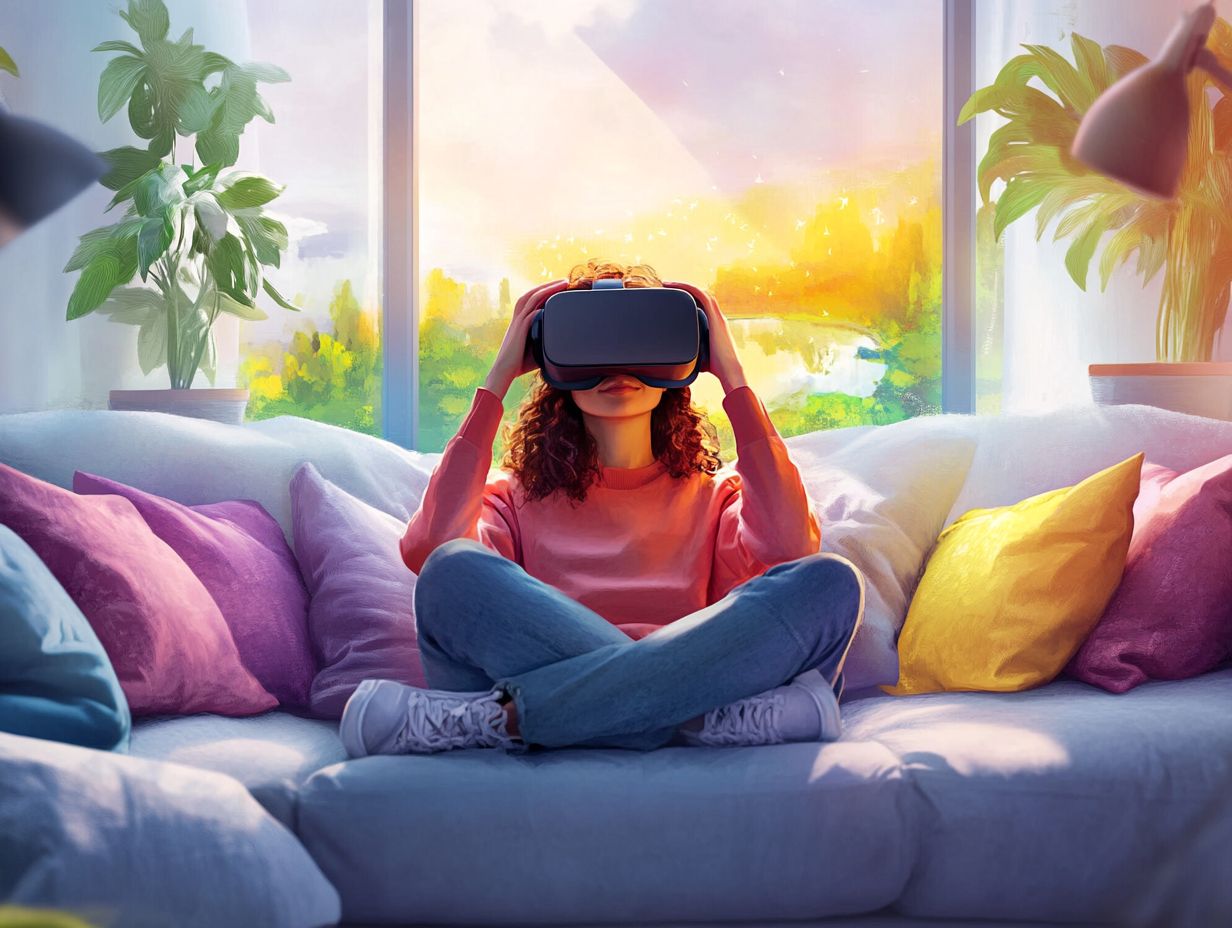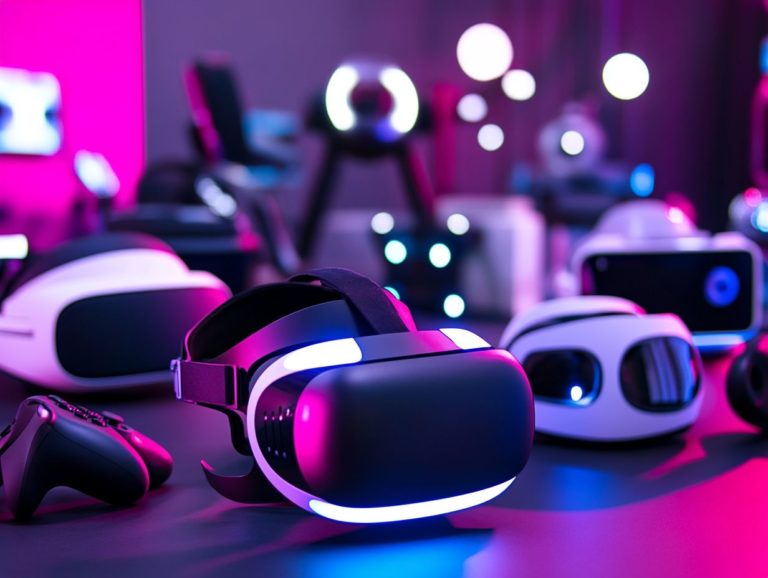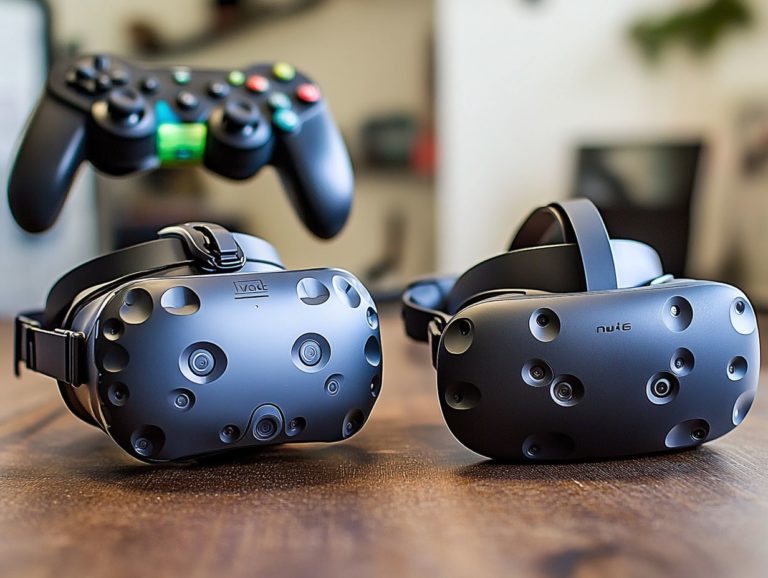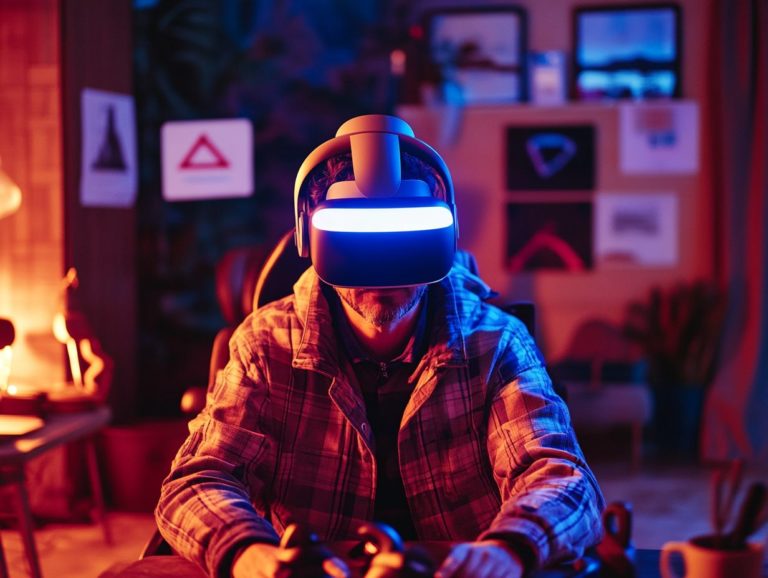understanding vr comfort: how to avoid motion sickness
Virtual reality (VR) provides an immersive experience that s truly unparalleled. However, it can sometimes bring about discomfort, especially when it comes to motion sickness.
This article delves into the concept of VR comfort and illuminates the science behind motion sickness and its various causes.
Explore practical tips and preventive measures designed to elevate your VR experience. This will allow you to fully enjoy your virtual adventures without those unwelcome side effects.
Whether you re a seasoned veteran or just dipping your toes into the world of VR, this guide will empower you with the insights needed to navigate your virtual landscape with ease and comfort.
Contents
- Key Takeaways:
- Causes of Motion Sickness in VR
- Ways to Avoid Motion Sickness in VR
- Best Practices for VR Comfort
- Dealing with Motion Sickness in VR
- Frequently Asked Questions
- What is VR comfort and why is it important?
- What is motion sickness and why does it occur in virtual reality?
- How can I prevent motion sickness when using virtual reality?
- What is “VR sickness” and how is it different from motion sickness?
- Are there any long-term effects of VR sickness?
- What are some tips for maximizing VR comfort and minimizing motion sickness?
Key Takeaways:

- Understand the causes of motion sickness in VR.
- Take breaks and use a comfortable headset.
- Adjust graphics settings to reduce discomfort.
- Use smooth movements and avoid sudden changes in direction.
- Create a comfortable environment for your VR experience.
What is VR Comfort and Why is it Important?
VR comfort encompasses your overall experience and physical well-being while navigating virtual reality environments. Achieving the right level of comfort is essential as it directly impacts your user experience, immersion, and the likelihood of encountering symptoms like dizziness and nausea.
With VR headsets becoming increasingly common in gaming and training solutions, understanding how to cultivate a comfortable experience is key to preventing discomfort and enhancing your enjoyment. This concept includes various factors, such as the weight and fit of the headset, the quality of visuals, and the responsiveness of the virtual environment.
When you feel comfortable, you re likely to stay engaged for longer. This allows for deeper interaction with the virtual elements around you. Staying engaged is vital, not just for gaming but also for learning and professional training! Don’t miss out on the full potential of your VR experiences!
Utilizing ergonomic tools and materials that prioritize health considerations is vital in managing discomfort. This ensures you can fully immerse yourself without the nagging worry of adverse physical effects. Ultimately, prioritizing VR comfort leads to richer experiences and more effective outcomes.
Causes of Motion Sickness in VR
Motion sickness in virtual reality, commonly known as VR motion sickness, arises when there s a disconnect between the visual stimuli you see and the physical sensations your body feels.
This sensory conflict can trigger symptoms like dizziness and nausea, particularly during intense gaming sessions or immersive experiences.
Factors such as refresh rate and latency can greatly influence your overall experience. It s crucial to be aware of these elements to enhance your enjoyment and comfort in virtual environments.
Understanding the Science Behind Motion Sickness
Understanding the intricacies of motion sickness requires an exploration of how your sensory systems collaborate to maintain balance and spatial awareness.
In virtual reality, that immersive experience can create a dissonance between what you see and how your body moves. This can lead to symptoms like dizziness and eye strain. This disconnect can also impact your body s ability to regulate temperature, adding another layer of complexity to your experience.
As you interact with these immersive environments, your eyes perceive a scene that suggests movement, while the part of your body that helps you balance remains still. This mismatch can confuse your brain, resulting in discomfort and disorientation.
A higher body temperature can make these sensations worse, as your body grapples with various stressors. Prolonged focus on screens can lead to eye strain, further intensifying feelings of nausea and discomfort.
Grasping these interactions paves the way for developing effective strategies to alleviate these unpleasant symptoms.
Ways to Avoid Motion Sickness in VR

Preventing motion sickness in virtual reality is crucial for an enjoyable experience. You can achieve this through several effective strategies.
Here are some simple tips:
- Reduce your exposure time.
- Use motion sickness remedies.
- Gradually build your tolerance.
These techniques can significantly alleviate symptoms like nausea and dizziness. Mental acclimatization is essential; it helps you adapt to the virtual environment, reducing discomfort during your gaming sessions.
Embrace these strategies to elevate your VR adventures!
Preventive Measures and Tips
Using preventive measures and simple tips can enhance your comfort and reduce the chances of motion sickness during VR sessions.
First, ensure your VR headset fits well. Straps should be snug but not too tight for a stable experience. Adjusting the distance between your eyes helps create clearer visuals, reducing eye strain. Additionally, ergonomic tools like cushioned grips and harnesses provide extra support.
Remember to take regular breaks to recalibrate your senses. During these breaks, practicing breathing techniques can foster a sense of calm. Deep, controlled breaths ground you, making you more resilient to sensations of unease during intense gameplay.
Best Practices for VR Comfort
Achieving optimal VR comfort requires understanding headset calibration, user accessibility, and effective discomfort management strategies.
Make sure your headset fits correctly and is calibrated to your unique eye distance. This allows you to fully immerse yourself in the experience without dizziness or nausea.
Adopting these best practices is essential, whether you re a casual gamer or a professional in VR training.
Creating a Comfortable VR Experience
Get ready to dive into a thrilling VR adventure by ensuring your headset fits just right! Pay attention to the settings that optimize refresh rate and spatial tracking capabilities.
A well-fitting headset minimizes discomfort and enhances immersion, allowing you to engage fully without distractions like eye strain or dizziness.
Ensure the headset is snug but not overly tight, as this significantly impacts your experience. Adjusting the distance between your eyes can improve clarity and cater to your vision needs.
Also, consider the dimensions of your play area and calibrate spatial tracking properly. This ensures smooth navigation through the immersive environment.
By fine-tuning these settings, you maximize comfort and enrich your exploration of virtual worlds, allowing you to appreciate the intricate details that make VR captivating.
Dealing with Motion Sickness in VR

Navigating motion sickness in virtual reality can be a challenge, but by recognizing the symptoms and applying effective strategies, you can significantly enhance your experience.
Consider using motion sickness medications like Dramamine or natural remedies such as ginger to ease discomfort. Employing relaxation techniques and practicing controlled breathing can also help manage symptoms like dizziness and nausea, allowing you to fully immerse yourself in the virtual world.
Don’t wait! Implement these tips now to enjoy an uninterrupted VR experience!
How to Handle Motion Sickness if it Occurs
To manage motion sickness when it strikes, you must first recognize the symptoms, such as dizziness, nausea, and eye strain. Taking a break from the VR experience and adjusting comfort settings can help your body recover.
By adopting these practices, you can enhance your experience and reduce the chance of recurring symptoms.
Being aware of your reactions is key to alleviating discomfort. Here are a few strategies:
- Lower the game’s graphics settings or adjust the field of view to minimize distractions.
- Start with short play sessions and gradually increase your time.
- Keep your head stable and ensure good ventilation in the room.
Stay hydrated and practice deep breathing. These simple changes can make your gaming experience much more enjoyable!
Frequently Asked Questions
What is VR comfort and why is it important?
VR comfort means how comfortable you feel when using virtual reality technology. Understanding it is crucial as it can greatly impact your overall experience and prevent motion sickness.
What is motion sickness and why does it occur in virtual reality?

Motion sickness includes nausea and dizziness while using virtual reality. It happens when what you see doesn t match what your body feels.
How can I prevent motion sickness when using virtual reality?
To prevent motion sickness in VR, take frequent breaks, use stationary experiences, adjust the field of view, and consider anti-nausea medications.
What is “VR sickness” and how is it different from motion sickness?
VR sickness refers specifically to symptoms experienced during virtual reality use, such as nausea and disorientation. While motion sickness can happen in various scenarios, VR sickness is unique to VR experiences.
Are there any long-term effects of VR sickness?
Currently, there is no evidence that VR sickness has long-term effects. However, it can greatly impact your experience and might make you hesitant to use VR in the future.
What are some tips for maximizing VR comfort and minimizing motion sickness?
- Choose experiences with slower movements.
- Avoid sudden or jerky motions.
- Use high-quality VR equipment with low latency and high refresh rates.





